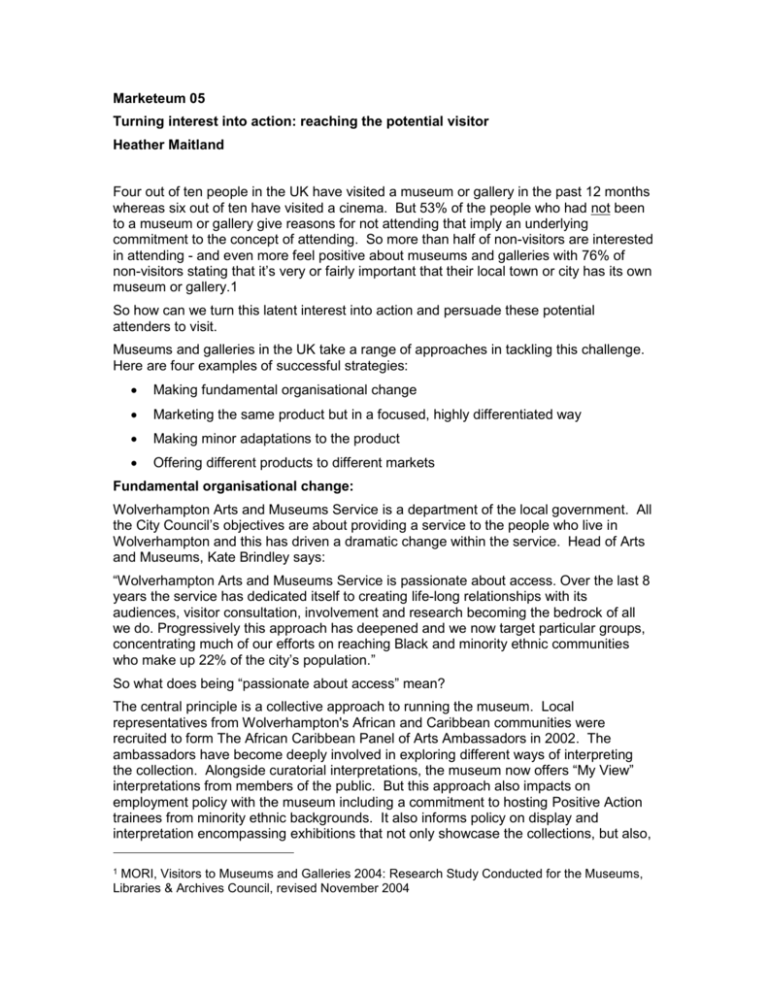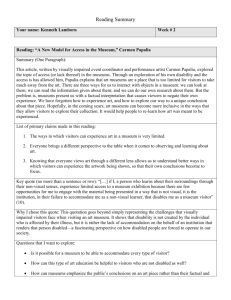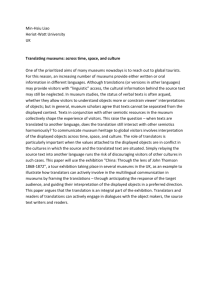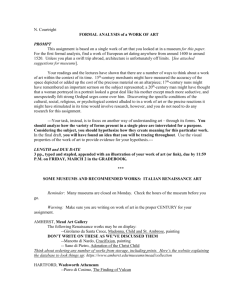Marketeum-Turning-Interest-into-Action
advertisement

Marketeum 05 Turning interest into action: reaching the potential visitor Heather Maitland Four out of ten people in the UK have visited a museum or gallery in the past 12 months whereas six out of ten have visited a cinema. But 53% of the people who had not been to a museum or gallery give reasons for not attending that imply an underlying commitment to the concept of attending. So more than half of non-visitors are interested in attending - and even more feel positive about museums and galleries with 76% of non-visitors stating that it’s very or fairly important that their local town or city has its own museum or gallery.1 So how can we turn this latent interest into action and persuade these potential attenders to visit. Museums and galleries in the UK take a range of approaches in tackling this challenge. Here are four examples of successful strategies: Making fundamental organisational change Marketing the same product but in a focused, highly differentiated way Making minor adaptations to the product Offering different products to different markets Fundamental organisational change: Wolverhampton Arts and Museums Service is a department of the local government. All the City Council’s objectives are about providing a service to the people who live in Wolverhampton and this has driven a dramatic change within the service. Head of Arts and Museums, Kate Brindley says: “Wolverhampton Arts and Museums Service is passionate about access. Over the last 8 years the service has dedicated itself to creating life-long relationships with its audiences, visitor consultation, involvement and research becoming the bedrock of all we do. Progressively this approach has deepened and we now target particular groups, concentrating much of our efforts on reaching Black and minority ethnic communities who make up 22% of the city’s population.” So what does being “passionate about access” mean? The central principle is a collective approach to running the museum. Local representatives from Wolverhampton's African and Caribbean communities were recruited to form The African Caribbean Panel of Arts Ambassadors in 2002. The ambassadors have become deeply involved in exploring different ways of interpreting the collection. Alongside curatorial interpretations, the museum now offers “My View” interpretations from members of the public. But this approach also impacts on employment policy with the museum including a commitment to hosting Positive Action trainees from minority ethnic backgrounds. It also informs policy on display and interpretation encompassing exhibitions that not only showcase the collections, but also, 1 MORI, Visitors to Museums and Galleries 2004: Research Study Conducted for the Museums, Libraries & Archives Council, revised November 2004 ‘acknowledge the contribution of incoming cultures to social, political and cultural change in England’. Recent projects have looked at the culture of African Caribbean hair-care and styling in Wolverhampton, performances from the local Black Readers and Writers Group, and a Caribbean themed opening for their Christmas exhibitions. This shift in approach to display and interpretation is much wider than offering activities targeted at particular sections of the community. It affects everything the Museum offers. At Your Pleasure takes a completely different approach to a room about the 18th Century. It now contains five pieces of modern craft furniture that are filled with objects from the 18th century to touch and smell, magnifying glasses so you can look at them closely and audio tapes so you can listen to voices telling you what life was like then. This fundamental change has been highly effective, bringing in new visitors from across the whole community. In fact, Wolverhampton is often cited as an example of how successful access policies can be. But there are drawbacks. Some existing loyal and frequent visitors have been alienated by the changes, although the permanent collection is still on display in a familiar setting. The policy has required a shift of resources away from the kinds of activities traditionally associated with museum marketing – away from a reliance on leaflets, posters and direct marketing aimed at regular attenders and towards people-to-people and mass marketing through the press and media. So what happens when an organisation with few resources, that must continue to focus on its existing core audience, decides that it also wants to develop new audiences? Highly focused, differentiated marketing The Women’s Library is the UK’s national collection of women’s history owned and managed by London Metropolitan University. In effect it is a combination of an archive and a museum – a cultural centre for social history. When they moved to a new site in 2002 from an under-used basement, they saw a 700% increase in visitors. This was great news, but it still did not address their objective to broaden their core audience base and to work with the communities in East London that now surrounded them. They had few resources so they focused on a small number of precisely targeted market segments: Academics and social historians Students on the London Metropolitan University City campus nearby Women living nearby People from across the UK interested in researching their family history So what did they do to reach these target groups? Their activities are centred on an exhibition and public talks programme based on innovative thinking about the way the collections are used. Exhibitions are planned through collaboration between the curators and the marketer. The Library sees the exhibitions as an entry point to the whole collection so the subject matter, images and title are framed to appeal to the non-specialist. Different sorts of talks are aimed carefully at different sorts of people as introductions to both individual exhibitions and the wider collection. The Library uses different communication styles and channels to match. For their exhibition on the history of beauty contests in 20th Century Britain, Beauty Queens: smiles swimsuits and sabotage, they had a “one day multi-disciplinary symposium exploring new ways of seeing the female body”. But alongside this was an event called Remembering Southend aimed at people exploring their own family history. The copy reads: “Why would an elderly Londoner have kept not just one, but three hideous ornaments from Southend? In this talk Dr Hilda Kean explores the ways in which Southend seaside souvenirs helped give her different insights into her grandmother’s life.” They also held Summer Sizzlers, inviting local children living within walking distance of the Library: “Brighten up your summer holidays and go glamorous at our free, fun drop-in activity sessions every week. Make a sash or a crown, a trophy or a rosette and join in a dress-up parade. With games and art activities for all ages from 2 upwards, you are sure to be a winner.” Inevitably for an organisation with few resources, The Women’s Library has a small and tightly focused outreach programme. But they achieve much more with those resources by working with partners that already have relationships with their target groups. For Beauty Queens, they worked with 2nd year BA Fine Art students the University’s Art School who curated a show of multimedia artwork and produced a book. They also worked with a local community group to produce a performance piece about ideas of beauty that brought together older women with young women from the local school. This brought local friends and families into the building for the first time. The Women’s Library used a mix of mass marketing and direct marketing: print distribution, direct mail, e-marketing and advertising plus a very successful PR campaign that achieved national, regional and local coverage in print, broadcast and web media. This exhibition attracted 5,600 visitors, an increase of 59% on previous exhibition. The outreach activities achieved great word of mouth publicity and so 77% of visitors were doing so for the first time. 88% of respondents to visitor survey said they would come again. The Women’s Library has a constantly changing temporary exhibition programme that they use as a shop window for the core collection. Many museums and galleries have core collections that are much more difficult to adapt in this way. Making minor adaptations to the product Tate Britain saw a decline in younger visitors when Tate Modern opened. The perception was that Tate Britain was stuffy and boring compared with Tate Modern. They succeeded in changing that perception through a relatively small change to the product surround. On the first Friday of every month, the gallery is open from 6 – 10pm, the only time the gallery is open after 6pm. There is a bar in the gallery and live music. Entry is half normal price but with no discounts. There is a theme for each event but the emphasis is on the social occasion. Ladies Night on 1st April offers “the possibility to bond, gossip and laugh … with a programme of film, talks, performance and music to inspire and titillate.” The events are marketed in a highly targeted way so they have little impact on how other target groups perceive Tate Britain. More drastic differentiation may be necessary. Different products for different markets: The Science Museum has been working to improve public understanding of science and technology since 1928. It has a strong brand and a high profile throughout the UK as a museum for the family. They do have a successful programme for adults, but research identified that the perception of the museum as somewhere for kids and their parents was alienating 18 to 30 year olds with no children. How could they become more appealing to adults without compromising either their brand or the family friendly experience they offer? Their response was to build the Dana Centre in the museum grounds. Its brand essence is to be ‘An accessible place for ‘talking science’ where everyone is equal and outcomes make a difference’. The Dana Centre is young, exciting, engaging and informal. It is a partnership between the Science Museum and two foundations, the Wellcome Trust and the European Dana Alliance for the Brain. Its aim is to challenge public perception about science and tackle contemporary issues head-on to enable people to have informed opinions about the incredibly rapid developments happening in science, technology and medicine. It’s a museum without a collection. Its centre is a bar/café not a lecture theatre. In that bar you’ll find a programme of mainly evening events including stand-up comics exploring scientific issues, art installations, live heart by-pass operations on the big screen, debates, art installations and live experiments. The strategy is to provide a highly focused programme aimed at culturally active people aged 18 – 30 living in London who would normally be more comfortable in a theatre or a gallery than thinking about science. It’s very successful with many events full to capacity. Everyone who attends has to book, even though events are free. This means that the Centre can capture every visitor’s name and email address in a very simple Excel spreadsheet. They then receive a monthly e-newsletter designed to move them through the carefully structured programme. The budget is small so the marketing mainly focuses on PR aimed at 18-30s, not just the upmarket, serious broadsheets but also the non-highbrow, non specialist glossy men and women’s magazines, ethnically diverse publications and student magazines. The only advertising appears in Time Out and New Scientist. So far I’ve described the strategies four museums in the UK have used to persuade many thousands of people to make their first visit. But have they achieved this by becoming inappropriately market-led? To explore this, we need to first look at what we mean in the museums sector when we describe organisations as market-led or productled: Organisations that are product-led tend to believe that: The right exhibitions will bring in visitors automatically What the museum offers is so good it should sell itself If visitors don’t come it’s their fault: they’re ignorant or unmotivated Marketing is just promotion These organisations don’t see themselves as competing for potential visitors’ leisure time or money. They undertake little or no research so they know correspondingly little about their existing or potential visitors. Organisations that are market-led tend to: Understand visitors’ needs and motivations Research and consult existing and potential visitors Have a primary focus on fulfilling visitor needs Divide visitors into target groups by looking at their relationship with your organisation Work to encourage repeat visits and develop loyalty Collect visitor data to enable relationship marketing Understand the marketplace, particularly the need to compete for visitors’ time and money Have a marketing focus throughout the organisation. Many museums believe that it is inappropriate for their organisations to focus primarily on fulfilling visitors’ needs. The very idea sparks talk of ‘compromise’ and ‘dumbing down’? There is another way of looking at this that perhaps better describes what the four museums I’ve just talked about are trying to do: Organisations with a visitor focus have the same characteristics as those that are market-led except for two very important differences - they: Fulfill visitor needs in order to achieve their own objectives Divide visitors into target groups not just by their relationship to the organisation but by their needs, motivations and attitudes The organisations I have described have thought carefully about their own objectives and then boldly and comprehensively focused on the target groups that will help them achieve those objectives. They have worked to understand those visitors’ needs and motivations. They have then looked at what they have to offer, how they offer it and how they communicate that offer in order to best fulfill those needs and motivations. These organisations are not ‘dumbing down’. These are organisation getting what they want.






